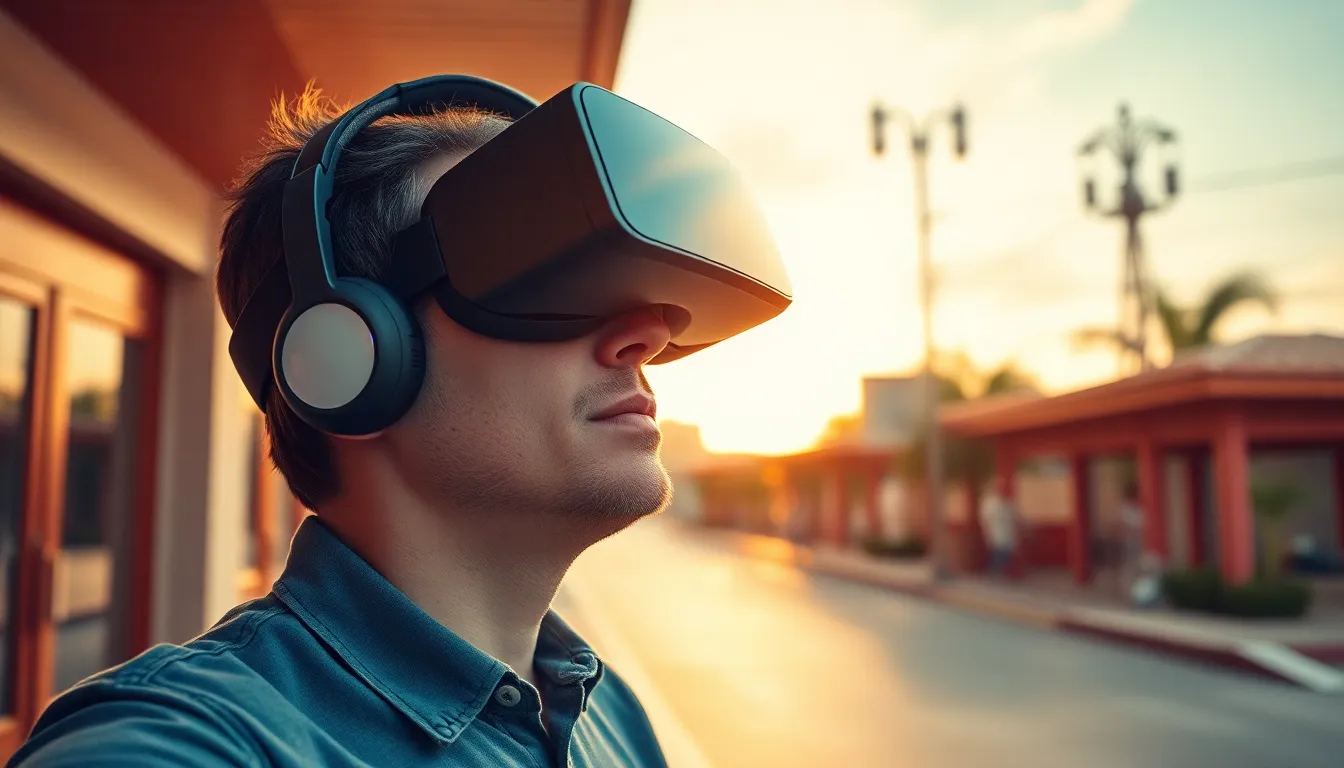Virtual reality has come a long way from clunky headsets and pixelated worlds. Next-gen VR is here to blow minds and redefine what it means to escape reality. Imagine stepping into a universe where the only limit is your imagination—no more awkward living room furniture collisions or headset malfunctions. It’s time to embrace a whole new level of immersion that makes gaming, training, and even socializing feel like a walk in the park—if that park is filled with dragons and laser tag arenas.
Table of Contents
ToggleOverview of Next-Gen VR
Next-gen VR represents a significant leap from earlier generations, marked by improvements in graphics, responsiveness, and user interaction. Enhanced hardware now features higher resolution displays, resulting in clearer and more vibrant visuals that elevate the immersive experience. Devices incorporate advanced tracking technologies that deliver seamless movement and accurate representations of real-world actions.
Artificial intelligence plays a crucial role in enhancing the VR experience. AI algorithms improve realism by adapting environments based on user behavior, creating dynamic scenarios that feel more engaging. In addition, machines equipped with AI can learn user preferences, offering personalized experiences that cater to individual tastes.
Interaction methods in next-gen VR have also evolved. Controllers now feature haptic feedback, allowing users to feel textures and resistance, which increases the sensory experience. Gesture recognition technology enables users to interact without physical controllers, making environments more intuitive and accessible.
The social aspect of VR presents exciting opportunities for connectivity. Platforms provide users with virtual spaces to meet, collaborate, and socialize, breaking geographical barriers. Communities centered around shared interests can thrive, fostering deeper connections among users.
Finally, applications extend beyond gaming and entertainment, influencing sectors like education and healthcare. Organizations utilize VR for training simulations, enhancing skills in safe environments. Similarly, VR provides therapeutic experiences, assisting in exposure therapy and pain management.
Overall, next-gen VR continues to reshape how individuals engage with digital environments, solidifying its place as a transformative technology across various fields.
Key Features of Next-Gen VR

Next-gen VR technology introduces transformative features that significantly enhance user experiences. By focusing on visuals and audio, this technology delivers immersive environments that engage users fully.
Enhanced Visuals
High-resolution displays provide crystal-clear images, elevating realism in virtual environments. Advanced rendering techniques improve graphics quality, ensuring vibrant colors and detailed textures. These developments foster greater immersion, allowing users to lose themselves in captivating worlds. With field of view improvements, users can enjoy broader perspectives, mimicking natural sight. Enhanced tracking systems ensure smooth movement, minimizing latency and motion sickness. As a result, these visual upgrades redefine how participants interact with virtual settings.
Immersive Audio Experiences
Three-dimensional audio contributes greatly to the immersion of next-gen VR. By utilizing spatial audio technology, sound feels as if it’s coming from specific directions. Users perceive more realistic environments as subtle sound cues enhance interactions. Incorporating dynamic soundscapes further enriches experiences, adapting audio to match user movements. Advanced noise-cancellation features create a focused auditory experience, reducing distractions from external noises. Total immersion unfolds as audio and visuals converge, transforming ordinary interactions into unforgettable experiences.
Technological Innovations
Next-gen virtual reality (VR) showcases groundbreaking advancements that significantly enhance user experience and engagement. These innovations involve sophisticated tracking systems and refined haptic feedback, both of which contribute to the immersive quality of VR.
Advanced Tracking Systems
Advanced tracking systems represent a pivotal shift in VR technology. High-precision sensors monitor user movements with remarkable accuracy, ensuring natural interactions within virtual environments. This level of tracking reduces latency and minimizes motion sickness, significantly improving comfort. Six degrees of freedom (6DOF) systems allow users to move freely in all directions, enriching the sense of immersion. Enhanced algorithms also facilitate real-time environment adjustments based on user actions. The combination of these technologies creates a seamless connection between the physical and virtual worlds.
Haptic Feedback Enhancements
Haptic feedback enhancements transform user interaction by providing tactile sensations that correspond with actions in virtual environments. Improved controllers deliver nuanced vibrations and forces, simulating real-world texture and resistance. Users touch, grip, and feel virtual objects more intuitively than ever before. This technology enriches the gaming experience and extends to applications in training simulations and therapy. As users engage with VR content, the feedback heightens emotional responses and deepens immersion, making experiences more memorable.
Applications of Next-Gen VR
Next-gen VR technology finds diverse applications across multiple sectors, transforming how people experience gaming, education, and healthcare.
Gaming and Entertainment
Gaming benefits from realistic graphics and intuitive controls. Players engage with high-resolution visuals that create lifelike environments. Immersive experiences emerge through advanced sound technology, allowing users to feel present in the game. Social features enable players to collaborate or compete with others in virtual spaces, enhancing interaction. Games using haptic feedback immerse users fully, simulating touch and movement. Thrilling scenarios become more vivid, producing emotional responses as players navigate challenges.
Education and Training
Training programs utilize VR to simulate real-world scenarios. Educational institutions create immersive environments where students can explore intricate topics in a hands-on manner. Trainees engage in practical exercises without real-world consequences, boosting confidence and skill retention. Interactive lessons foster active learning, allowing learners to manipulate virtual objects for deeper understanding. Professionals in fields like aviation and emergency services benefit from realistic simulations, improving preparedness. Flexibility in design ensures that educational content can adapt to various learning styles.
Healthcare and Therapy
Healthcare applications of VR offer new therapeutic possibilities. Patients experience reduced anxiety during procedures through calming virtual environments. Therapists use VR to treat phobias, allowing clients to confront fears gradually in a controlled setting. Rehabilitation programs incorporate VR exercises, helping patients regain motor skills while keeping them motivated. Pain management techniques leverage immersive experiences to distract patients from discomfort. These applications demonstrate VR’s broad impact on mental and physical health, offering innovative solutions for recovery and emotional support.
Challenges and Considerations
Next-gen VR faces significant challenges that impact its widespread adoption and ethical deployment. Addressing these issues is crucial for maximizing the technology’s benefits.
Accessibility and Affordability
Accessibility remains a pressing concern in the VR landscape. High costs associated with devices often limit entry for many users. Affording premium headsets and compatible hardware poses a barrier for low-income individuals and institutions. Commercial success depends on manufacturers offering more affordable options without sacrificing quality. Lowering prices can enhance accessibility and expand user bases significantly. Efforts to develop budget-friendly devices will ensure that diverse demographics can experience VR technology. Designing software that requires less powerful hardware can further improve accessibility.
Ethical Implications
Ethical considerations in VR include privacy, data security, and behavioral influence. Users share their personal data with VR platforms, raising concerns over privacy breaches. Developers must establish robust data protection measures to maintain user trust. Additionally, VR experiences can shape behaviors, creating potential for both positive and negative influences. Ensuring responsible content creation and monitoring dangerous scenarios is vital. Supporting regulation on ethical standards will foster a safer virtual environment for all users. Addressing inclusivity in content design can also help mitigate biases, enhancing overall user experiences.
Next-gen VR is reshaping how individuals interact with technology and each other. With advancements in graphics, tracking, and user engagement, it’s paving the way for immersive experiences that extend far beyond gaming. The potential applications in education and healthcare highlight its versatility, offering innovative solutions for learning and therapy.
While challenges like accessibility and ethical concerns remain, the future of VR looks promising. As technology continues to evolve, so will the opportunities for deeper connections and transformative experiences. Embracing these advancements ensures that VR can become an integral part of everyday life, enriching both personal and professional realms.




